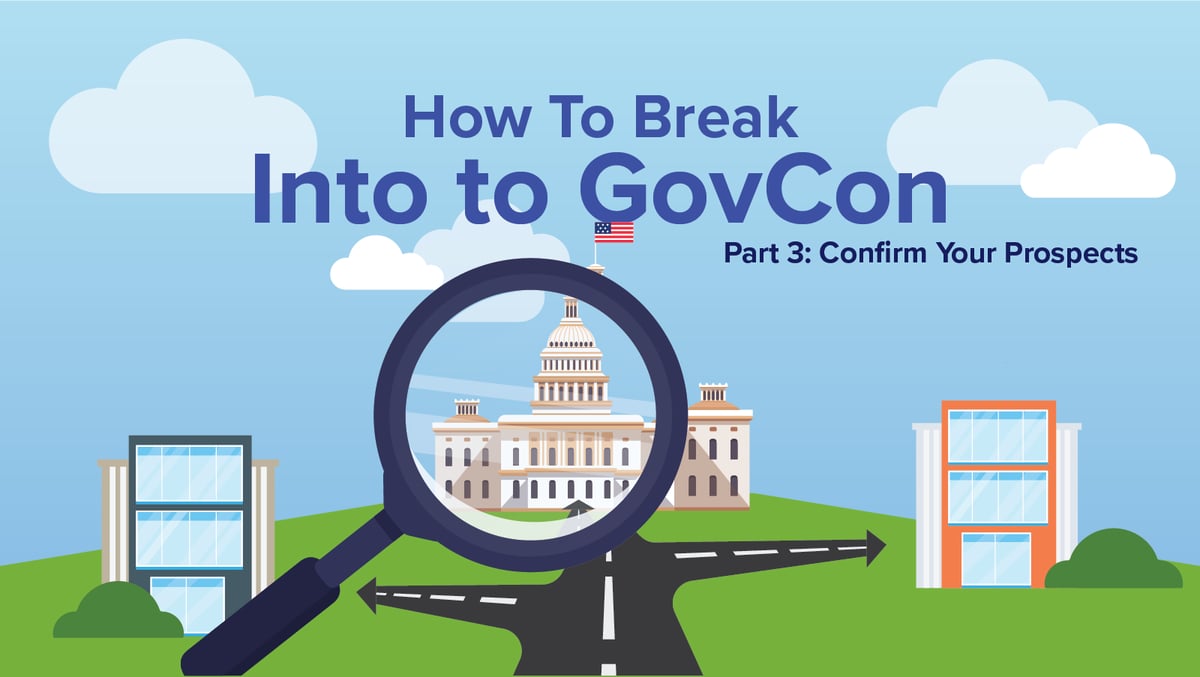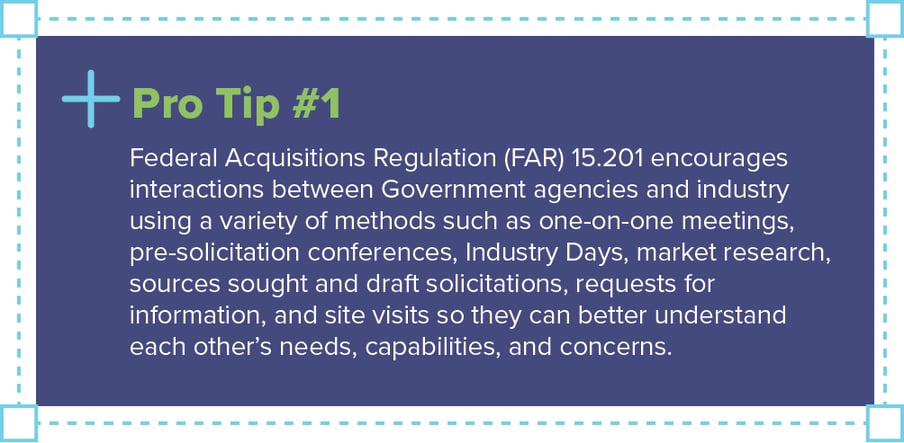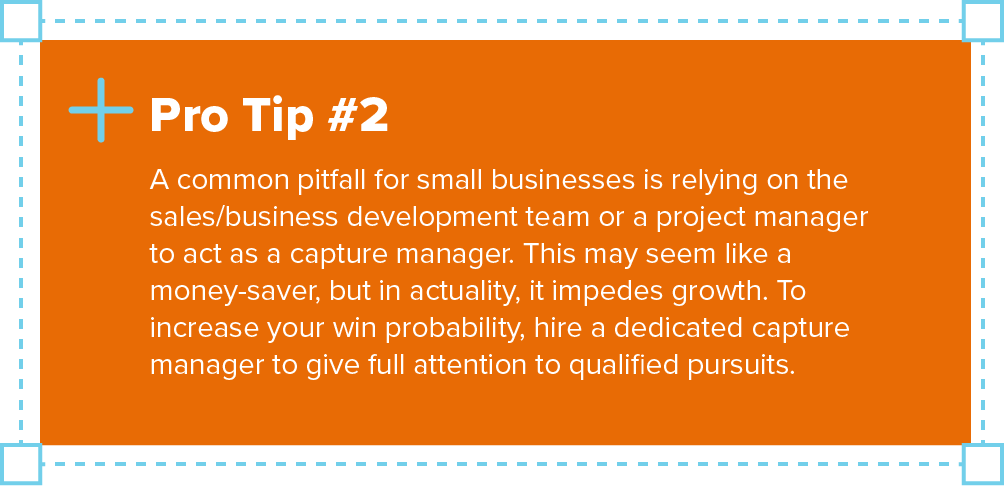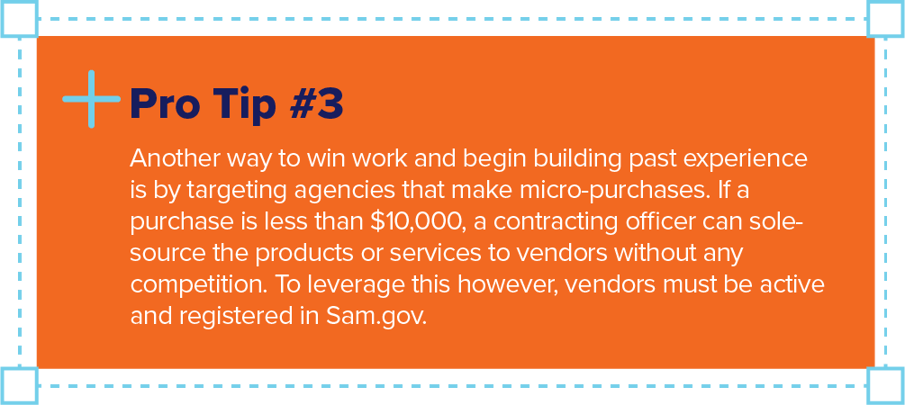
Targeting and building your business development pipeline can feel daunting because of the endless pool of prospects.
USA.gov lists over 400 agencies and sub-agencies in the federal government. Within each of those are a multitude of individual business units and departments. Together, they add up to thousands of potential government buyers. So where do you begin? Start by defining your ideal government buyer. Understanding who that is will steer every decision you make as you build your pipeline and compete for work.
This is the third article in our "Small Business Guide to GovCon" series focused on helping small businesses break into government contracting. The series breaks down the "Six C's to Success" small businesses need to enter and succeed in the world of GovCon.
Posts include:
- Introduction (Know Your Basics)
- Clarify Your Brand
- Confirm Your Prospects
- Connect with Customers
- Conquer Roadblocks
- Capture Opportunities
- Compete to Win

The first introductory article defines what government contracting is and describes the steps businesses must take to begin working with the government. The second article explains the first “C” to success—Clarify Your Brand—and contains exercises and resources to help businesses clearly define who they are, what they do, and how they stand out from their competitors.
In this article, we delve into the second “C” to success—Confirming Your Prospects. You'll learn how to target and understand your ideal government buyer.
Confirming Your Prospects
To succeed in government contracting, you need to know when to forgo opportunities.
This is not meant to limit your potential to make a profit but rather to narrow your focus on efforts you’re more likely to win. Contracting officers must bid every requirement and have an obligation to award many opportunities to small businesses.

However, as discussed in previous articles, contracting officers are risk-averse and reluctant to do business with new and unknown vendors. Avoid bidding on opportunities if you don’t know the buyer, the competition, the budget, or the project scope. Instead, do your research and begin developing relationships with agencies that already buy what you deliver.
Following the three steps below can minimize the costs of building your pipeline.

1. Analyze Your Current Buyers
Strategic government business advisor, Judy Bradt, explains: “Whether you sell a service or a product, you must be able to identify which government buyers are most similar to your sweet spot clients today.” To do this, make a list of your most loyal customers and then ask yourself the following questions:- What do your most loyal customers have in common?
- Are they in the same industry or geographical location?
- Are they buying the same services/products from you? How often are these individuals buying from you?
- Do you see a trend in their buying habits?
- What are the sizes, missions, and scopes of work of these customers? What do they specialize in and why do they need what you sell/offer?
- Are any of these customers already in the agencies you want to target? You can leverage and reference your past experience with these customers as you introduce your offerings to potential government Contracting Officers. In addition, your current customers can potentially link you to companies/agencies with whom they do business, so hone in on those customers who are already in the government space
- What is your Unique Value Proposition (UVP) and how well does it align with your agency prospects?
2. Target Government Prospects
Analyze the information you gathered in Step 1—consider size, scope, scale, mission, and location—and determine which federal agencies are most like your chosen list of customers.

Target agencies in which you have existing and established relationships. If this doesn’t apply to your situation, narrow your choices by asking:
- Which government agencies are buying what you sell? Are they similar in size, scope, mission as your current customers?
- Within those agencies, which departments can your products and services best support? How are those departments organized?
- What programs do those departments run and who manages them?
- How much are they buying? When are they buying?
- Which contracting vehicles are they using to buy?
- What kinds of challenges or problems are they experiencing?
- Who else are they buying from? (Remember, your competitors are possible teaming partners.)
Once you have compiled a list of prospects, down-select the options and choose your top five agencies to target.
3. Research Your Top Five Prospects and Identify Contacts
Conduct research using Sam.gov to learn more about your top five agencies and to collect contact information for the contracting officers who buy for them.
Begin by searching keywords related to the products and services you offer such as "Professional Services." Refine your search by entering the name of the federal agencies you want to research. Hit enter to produce the relevant search results. Scroll through the results for specific contract details and to obtain contact information for each contract’s designated contracting officers. You can also search by NAICS code and agency as seen in the screengrab below.
SAM.GOV allows you to research opportunities and find prospects by NAICs code, agencies, and/or keywords.
In addition to identifying contract officer information, your research can also reveal:
- Which of your competitors have been awarded work by your targeted agencies
- How much money your prospects spend on the products and services you provide
- Future bidding opportunities
USAspending.gov is another valuable resource for conducting research. It is the official source for government spending data—detailing how and where the government spends its money. You can follow the funding from Congressional appropriations and federal agencies to local communities and businesses. Its Award Search and Profiles features allow you to easily find contract award and entity spending data.

Other Ways to Target Prospects
Sam.gov and usaspending.gov are excellent tools for identifying prospects and developing your prospect list. However, other ways to collect this information include researching:
- Agency websites- investigate posted organizational charts to find contact information and department-specific information.
- LinkedIn- search for key personnel working within the agencies you wish to target.
- State Local and Educational (SLED)- don’t overlook state, local, and educational organizations. These opportunities can help get you in the door of “government”—beyond private, commercial buyers—so you can build experience in the public space.
- Procurement Technical Assistance Centers (PTAC)- contact your local program for help identifying and matching to agencies that already buy what you offer.
- Online marketplaces- identify agencies buying online that purchase what you offer. According to a report by Censeo Consulting Group, government buyers and small businesses are turning to online business-to-business (B2B) marketplaces to improve the procurement process and reduce the barriers to entry for small businesses who want to work in the federal space.
- Network meetups, industry days, join relevant organizations- attend the same conferences and events as your prospects to grow your network and build your prospect list
- Small Business (SB) Liaison Officer or SB Specialist/Advocate or Office of Small and Disadvantaged Business Utilization (OSDBU)- contact the OSDBU within the agencies you targeted. They specifically advocate and advance the business, regulatory, and environmental compliance concerns of small and socio-economically disadvantaged businesses.
- Agencies that haven’t met their SB goals- target those agencies that haven’t met their SB goals. They have a requirement to meet SB goals and will want to raise the results on their scorecard.
Conclusion
To succeed in government contracting, you need to target and understand your ideal buyer, their budget, and their buying habits. To do this effectively, identify your “best-fit” agencies by comparing them against your most loyal customers. Then conduct research and pinpoint the contracting officers who already buy what you deliver within those targeted agencies. The time spent on market research will ensure you avoid the hefty costs of pursuing agencies and opportunities outside of your sweet spot.
The next article of this series will build on your market research and discuss how to develop relationships with your top five prospects as we examine the next “C” to Success—Connect with Customers.
To begin conducting your own research and building your pipeline and prospect list, visit the following websites:
- https://www.acquisition.gov/procurement-forecasts
- https://www.usaspending.gov/
- https://sam.gov/content/home
- https://www.fpds.gov/fpdsng_cms/index.php/en/ (until May 24th, 2022)

Article References:
- Bradt, Judy. Government Contracts Made Easier. Middletown, DE: Summit Insight, 2019.
- Censeo Consulting Group. “Cracking the Government Procurement Code”. https://www.censeoconsulting.com/insight/cracking-the-government-procurement-code-new-study-details-barriers-small-businesses-face-selling-to-government-customers-and-how-online-marketplaces-can-help/. March 20, 2020
- “8 Tips for Finding Government Contracting Opportunities.” Subcontractors USA. https://subcusa.com/8-tips-finding-government-contracting-opportunities/. November 2017.







